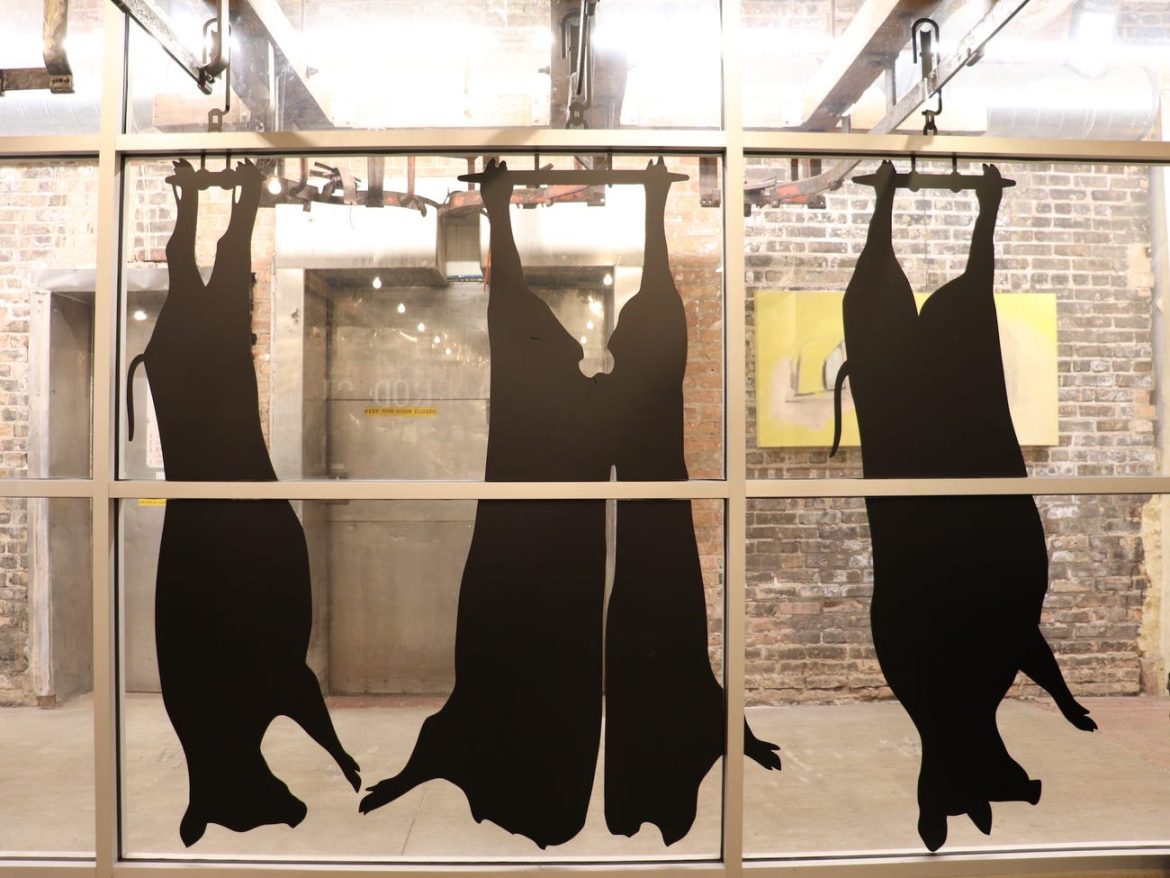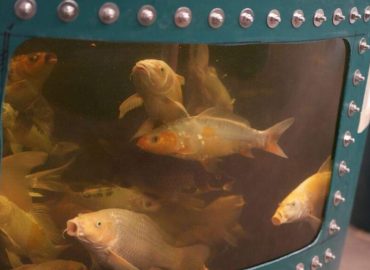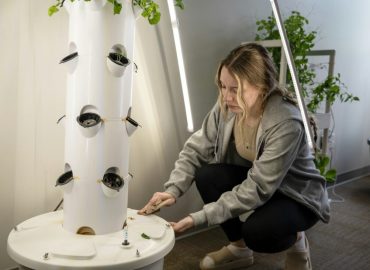The Plant Chicago

Small businesses turned an old Chicago meatpacking plant into a living experiment in sustainable food, and they are thriving
The Plant Chicago | Morgan McFall-Johnsen |
IMAGE:John Edel bought The Plant as a decrepit meatpacking facility and turned it into a sustainability haven. Morgan McFall-Johnsen
CHICAGO — A giant, blocky, red-brick building rises above a sea of two-story houses, filling an entire city block in the Back of the Yards neighborhood.
The area is named for the stockyards at the turn of the 20th century: a square mile of tight pens stuffed with livestock and slaughterhouses. Workers lived in slums, and the industry carelessly dumped so much waste and blood into the river that the water began to bubble and emit a foul stench from the gasses of decomposing carrion.

Chicago was the nation’s meatpacking capital, and this 100,000-square-foot structure used to be a meatpacking plant. Today, two turtles, Justine and Laupland, lounge in a small wetland just inside the building’s entrance.

Upstairs, someone checks the roastery’s books among bags of fragrant coffee beans, while cheese chills in a cooler, bees make honey on the roof, and four researchers in a laboratory raise a glass to their experimental algae. In the basement, rows and rows of small edible plants stretch toward grow lights.

On the ground floor, where a giant meat freezer used to be, a brewery is throbbing with heat and the hum of heavy machinery.
“Brewing is important to us because it’s the low-hanging fruit of energy and waste recovery,” John Edel, who bought this building in 2010, shouted to Insider over the roar of sours and ales brewing. “There’s wastewater, there’s grains, there’s yeasts, there’s heat. All of those things can be salvaged.”

The brewery, run by Whiner Beer Co., helps heat the building in winter. Spent grain becomes compost for farms on the property. As the beer ferments, it emits carbon dioxide, which is piped to the labs upstairs to feed growing algae. The grain has also been used to grow mushrooms in the basement and bake bread upstairs.

Through a decade of tinkering, this colossal relic of one of the Midwest’s biggest and dirtiest industries has become a playground for small businesses trying to produce food sustainably. It’s called The Plant.

Edel and his tenants have strung together a brewery, a bakery, small farms, and more to approximate what they call a “closed loop,” where the waste of one business helps make a product in another.

The Plant is not inventing technology. Rather, it’s finding creative ways to connect the dots with existing tech. The whole building is a living experiment.
It also offers an affordable, incubatorlike space for small businesses to establish themselves, cut costs by sharing resources, and learn from each other. The Plant is home to 105 full-time jobs, according to Edel.

“Our purpose is to push the boundaries of what can be done in technology and job creation,” he said, sitting in the bustling taproom down the hall from the brewery.
As he spoke, Edel stretched two thin, dirt-dusted fingers into his half-full beer glass to pinch a fungus gnat out of the golden liquid. The bug must have made itself at home in the live plants rooted in a strip of dirt and rock running down the center of the long wooden table.

Similar garden centerpieces sprouted from other tables in the dim light of the large concrete and brick chamber. Patrons talked, gestured, and laughed through gaps in the broad leaves, giving the space a buzz as lively as its greenery.
“I think people mostly regard us with curiosity, like, ‘What is this strange place and what do you do in there?’” Edel said. “We try to make it as inviting and open as possible for people to come in and learn what we do and hopefully learn about some aspect of food production or sustainability or loop closing.”
Built for pork and beef but perfect for indoor farms

This building was made for large-scale food production. It has US Department of Agriculture-grade pitched floors with drains, and the walls and ceilings are waterproofed throughout. Plus, the structure is built to withstand heavy equipment on all floors.
Those features were essential for processing pig carcasses, but they come in handy for indoor farming, too.
“There’s a value to a building like this that would never make good condos. It was designed to make food,” Edel said. “And it doesn’t have to be meat. It can be edible flowers.”

There are four farms at The Plant, some indoors and some outside on the facility’s lot. Until a few years ago, there was even a mushroom farm in a large basement room, which maintained 99% humidity for the fungi.
Today, Closed Loop Farms grows microgreens in that room for restaurants and at-home delivery. Imperfect or used-up plants become compost for the outdoor farms. It’s still humid.

“It is ideal for incubating small startup farming businesses because it is ugly space with no natural light in a basement that is cheap but food grade,” Edel said.
Recently, one of the farm businesses grew so much that it moved into an old Target building for more space.

The food-friendly facilities have helped other young businesses gain their footing and grow from The Plant.
Earlier this year, Shawn Smith and Leonor Quezada moved their Texas barbecue business, Heffer BBQ, into the Whiner Beer taproom. The brewery had been serving food but wanted to outsource that work so it could focus on beer. Smith and Quezada had just finished a residency and needed a home for their barbecue.
“Their beers pair extremely well with our food,” Smith told Insider as he sipped a cucumber-lime sour. “We’re already doing better here than we did for our residency.”

Jana Kinsman got her footing at The Plant, too. She moved her beekeeping business onto the roof about eight years ago. At the time, a tenant was keeping a garden up there and thought her bees would be beneficial.
“It was a major upgrade. It had water, a floor drain, electricity, all these things I didn’t have before,” she told Insider, adding that it was helpful to share materials and tools with the other businesses in the building.
“Everyone kind of has that mentality of using each other’s garbage,” she said.
In the ‘cool ship,’ bacteria from the farms help brew beer
Tucked in the back of the brewery, hidden behind a plywood board, is a small room wrapped in tubing that once piped ammonia for refrigeration. A giant vat fills the space. It was covered with a wooden board on this visit, but it’s often full of beer or, sometimes, kombucha.

“We put in a duct that pulls air from above one of the outdoor farms and basically coughs it onto the surface of hot beer that’s come out of the brewing process,” Edel said.
That will “basically infect the beer” with bacteria that help it ferment, he added. Bowed wood from barrels hangs on the ceiling above to attract bonus bacteria, which live in the wood and later fall onto the surface of the beer.
They call this room “the cool ship.” Beer cools in the vat for about a week and a half before going to barrels to sit for another year and a half.

Not every experiment like this has worked. The bakery upstairs once tried fueling its ovens with spent beer grain, but it took more energy to make bricks of the grain than burning them produced.
Looming giant and shiny over the rows of vegetables in the backyard is one unsuccessful experiment Edel hasn’t given up on yet: the anaerobic digester.
The Plant’s white whale is turning food waste into cash

Anaerobic digesters are commonly used to dispose of animal manure or waste from sewage.
The plan for The Plant’s digester was that it would consume 32 tons of food waste each day and turn it into a liquid digestate, some compostlike solids, and biogas.
The biogas would power boilers throughout the building. The solids would enrich soil. The Plant’s laboratories could extract growth stimulants from the liquid for farming.
The digester is key to The Plant’s larger mission, Edel said: “coming up with ways to take the waste that surrounds us all and turn it into food and jobs.”

But the costs turned out to be more than expected. It would take another $2 million to get the digester up and running, according to Edel. For now, that’s not financially worth it.
“It would work but only marginally, and we need it to really sing,” he said.
That’s why the laboratories on the top floor are figuring out how to make the digester profitable.
The ultimate circle of food production

Leonard Lerer and three employees of his company, Back of the Yards Algae Sciences, sit among the whirring machines and tubes of floating algae in the laboratory.
The company’s primary mission is finding ways to use algae and fungi as replacements for artificial food additives: colorants, flavors, protein powders, and even plant stimulants for indoor farming.

On the side, Back of the Yards Algae Sciences has taken on the ambitious project of figuring out how to extract valuable molecules from waste in the anaerobic digester. The innovators believe they can pull antioxidants or vanilla, for example, from the digesting food waste and sell it.
If they can extract valuable molecules, Edel said, that will be the promise he needs to invest the $2 million to finish the anaerobic digester.
The labs are working on a pilot experiment with a mini digester to test their idea. Edel expects the pilot to start running in future months, he said.

Lerer’s hope is that the laboratory’s work, and implementation of these techniques in farms at The Plant, can help make vertical farming more sustainable and profitable. If it worked at scale, indoor vertical farming would use less land, energy, and water than traditional crop farms.
This is the ultimate circular vision for The Plant.
“Take the waste from vertical farming or food waste, put it in an anaerobic digester, generate energy — gas, or turn that into electricity. Use the digestive that comes off to feed algae. The algae make a biostimulant, which you give back to the plants, which allows it to grow,” Lerer said.

At the same time, his laboratory could extract food colorants or high-value molecules from the algae and the digester.
“There’s never any real waste,” he said.
Original Article: https://www.businessinsider.com/inside-the-plant-chicago-closed-loop-urban-food-production-experiment-2023-8
The post The Plant Chicago appeared first on GROZINE.



